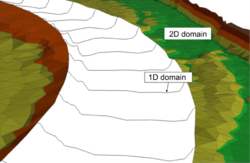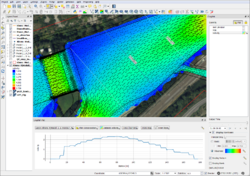Difference between revisions of "OpenFOAM"
Bendikhansen (talk | contribs) (Created page with "right =Quick summary= thumb|250px|Figure 1: Combination of 1D and 2D models in BASEMENT (source: VAW). file:basement_g...") |
Bendikhansen (talk | contribs) |
||
| Line 5: | Line 5: | ||
[[file:basemet_qgis.png|thumb|250px|Figure 3: Visualization of BASEMENT results with QGIS plugin Crayfish (source: VAW) (click to enlarge).]] | [[file:basemet_qgis.png|thumb|250px|Figure 3: Visualization of BASEMENT results with QGIS plugin Crayfish (source: VAW) (click to enlarge).]] | ||
| − | Developed by: | + | Developed by: 2018 (OpenFOAM release v1812) |
Date: May 2018 (Version 2.8) | Date: May 2018 (Version 2.8) | ||
| Line 14: | Line 14: | ||
=Introduction= | =Introduction= | ||
| − | + | OpenFOAM is a C++ toolbox for simulation of general continuum mechanics problems including the Navier-Stokes equations that mathematically describe the 3D motion of fluids. For simulations of free-surface gravity flows, the prebuilt Eulerian’ solver interFOAM is most suitable. The interFOAM solver identifies the interface between water and air based on the Volume Of Fluid (VOF) method and uses the PIMPLE algorithm for pressure-velocity coupling. The governing flow equations can be solved in combination with different approaches for turbulence modelling. In OpenFOAM, Reynolds-averaged Navier-Stokes (RANS) models using one or two equation turbulence models (e.g. k-ε model) as well as more computationally expensive large eddy simulation (LES) methods are available. An advantage of OpenFOAM, besides its free availability, is the use of body-fitted or unstructured computational grids. The additional use of polyhedral cells (in addition to hexahedral cells) allows even complex geometries to be accurately mapped (Figure 36). | |
=Application= | =Application= | ||
| − | The | + | The operating system for OpenFOAM is Linux and there is no official Graphical User Interface (GUI). The basic directory structure for an OpenFOAM case containing the minimum set of files required to run an application is shown in Figure 37. All the files can be accessed with a text editor. In the system directory, the parameters associated with the solution procedure itself are defined (e.g. start/end time, solution schemes). The constant directory contains the description of the mesh and files specifying the physical properties. The time directories contain data files that can be either initial values, boundary conditions or results written to file. |
| + | |||
| + | OpenFOAM is supplied with a pre- and post-processing environment. The interface to the pre- and post-processing are OpenFOAM utilities, thereby ensuring consistent data handling across all environments. The overall structure of OpenFOAM is shown in Figure 38. | ||
| + | In the pre-processing, simple meshes containing blocks of hexahedral cells can be generated by the blockMesh utility. For more complex geometries, the snappyHexMesh utility automatically generates meshes containing split-hexahedral cells by iteratively refining the starting mesh and morphing the resulting split-hex mesh to the triangulated surface of solid geometrical structures like power plant facilities (see Figure 37). Solid structures are represented in the form of stereolithographic files (STL). | ||
| + | The main post-processing tool provided with OpenFOAM is the reader module paraFoam that uses ParaView, an open-source visualization software to display geometry, computational mesh and simulation results (Figure 38). | ||
=Other information= | =Other information= | ||
| − | + | General advantages & disadvantages of the tool (no claim for completeness) | |
| + | + Open source software − Complex model setup (no GUI) | ||
| + | + Accurate representation of complex geometries due to unstructured or body-fitted computational grids − Definition of boundary and initial condition requires in depth knowledge of underlying concepts | ||
| + | + Growing user community (forum) − No standardized documentation | ||
| + | |||
=Relevant literature= | =Relevant literature= | ||
Revision as of 12:17, 24 June 2019
Contents
Quick summary
Developed by: 2018 (OpenFOAM release v1812)
Date: May 2018 (Version 2.8)
Type: Tool
Suitable for the following [[::Category:Measures|measures]]:
Introduction
OpenFOAM is a C++ toolbox for simulation of general continuum mechanics problems including the Navier-Stokes equations that mathematically describe the 3D motion of fluids. For simulations of free-surface gravity flows, the prebuilt Eulerian’ solver interFOAM is most suitable. The interFOAM solver identifies the interface between water and air based on the Volume Of Fluid (VOF) method and uses the PIMPLE algorithm for pressure-velocity coupling. The governing flow equations can be solved in combination with different approaches for turbulence modelling. In OpenFOAM, Reynolds-averaged Navier-Stokes (RANS) models using one or two equation turbulence models (e.g. k-ε model) as well as more computationally expensive large eddy simulation (LES) methods are available. An advantage of OpenFOAM, besides its free availability, is the use of body-fitted or unstructured computational grids. The additional use of polyhedral cells (in addition to hexahedral cells) allows even complex geometries to be accurately mapped (Figure 36).
Application
The operating system for OpenFOAM is Linux and there is no official Graphical User Interface (GUI). The basic directory structure for an OpenFOAM case containing the minimum set of files required to run an application is shown in Figure 37. All the files can be accessed with a text editor. In the system directory, the parameters associated with the solution procedure itself are defined (e.g. start/end time, solution schemes). The constant directory contains the description of the mesh and files specifying the physical properties. The time directories contain data files that can be either initial values, boundary conditions or results written to file.
OpenFOAM is supplied with a pre- and post-processing environment. The interface to the pre- and post-processing are OpenFOAM utilities, thereby ensuring consistent data handling across all environments. The overall structure of OpenFOAM is shown in Figure 38. In the pre-processing, simple meshes containing blocks of hexahedral cells can be generated by the blockMesh utility. For more complex geometries, the snappyHexMesh utility automatically generates meshes containing split-hexahedral cells by iteratively refining the starting mesh and morphing the resulting split-hex mesh to the triangulated surface of solid geometrical structures like power plant facilities (see Figure 37). Solid structures are represented in the form of stereolithographic files (STL). The main post-processing tool provided with OpenFOAM is the reader module paraFoam that uses ParaView, an open-source visualization software to display geometry, computational mesh and simulation results (Figure 38).
Other information
General advantages & disadvantages of the tool (no claim for completeness) + Open source software − Complex model setup (no GUI) + Accurate representation of complex geometries due to unstructured or body-fitted computational grids − Definition of boundary and initial condition requires in depth knowledge of underlying concepts + Growing user community (forum) − No standardized documentation
Relevant literature
- Vetsch D., Siviglia A., Caponi F., Ehrbar D., Gerke E., Kammerer S., Koch A., Peter S., Vanzo D., Vonwiller L., Facchini M., Gerber M., Volz C., Farshi D., Mueller R., Rousselot P., Veprek R., Faeh R. 2018. System Manuals of BASEMENT, Version 2.8. Laboratory of Hydraulics, Glaciology and Hydrology (VAW). ETH Zurich. Available from http://www.basement.ethz.ch.
Contact information
Website (download, tutorials, etc.): http://www.basement.ethz.ch
Email: basement@ethz.ch



